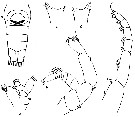|
|
 |
|
Calanoida ( Order ) |
|
|
|
Arietelloidea ( Superfamily ) |
|
|
|
Heterorhabdidae ( Family ) |
|
|
|
Neorhabdus ( Genus ) |
|
|
| |
Neorhabdus falciformis (Wolfenden, 1911) (F,M) | |
| | | | | | | Syn.: | Hemirhabdus falciformis Wolfenden, 1911 (p.310, Descr.F, figs.F, Rem.M) | | | | Ref.: | | | Heptner, 1972 a (p.59); Bradford-Grieve & al., 1999 (p.883, 943, figs.F,M); Park, 2000 (p.63, Redescr.F,M, figs.F,M, Rem |  issued from : T. Park in Bull. Scripps Inst. Oceanogr. Univ. California, San Diego, 2000, 31. [p.189, Fig.37]. Female: a, habitus (left); b, urosome (left); c, urosome with 2nd somite deeply telescoped (left); d, urosome (dorsal); e, genital somite (ventral); f, left Mx1 (posterior); g, left Mx2 (posterior); h, right Mxp (anterior). Nota: Prosome about 3/4 length of body and about3.1 times as long as urosome. Cephalosome about 2/5 length of prosome. Urosome about 1/4 length of body.. Dorsally, genital somite about as long as wide, with only slightly curved lateral margins; laterally, genital somite with a high genital prominence, deeper than long, typically with a deepth-length ratio of 100:85. Ventrally, genital operculum typically with a width-length ratio of 100:67 and 1/2 as wide as somite itself (as in N. latus). A1 reaching about posterior end of caudal ramus, its setation as in N. latus, segments 6-12 each with 2 setae, but the number of aesthetes on these segments are 2, 1, 3, 1, 0, 0, 0, (instead of 4, 2, 3, 2, 1, 1, 1, as found in N. latus) Male: i, basipods of P5 (anterior); j, basis and exopod of right P5 (anterior); k, basis and exopod of left P5 (anterior). Nota: Prosome about 3/4 length of body and about 3.0 times length of urosome. Left genicular A1 with many aesthetes on segments 1-9, similar in setation to that of N. latus male. Other cephalosomal appendages and P1 to P4 as in female. P5 similar to that of N. latus male but differs from it: 1- Inner lobe of right basis relatively short (Fig.37-i), with convex outer margin, 2 - 3rd segment of right exopod (Fig.37-j) with only 1 outer spine and 2 elevated pores (intead of 2 outer spines and 3 elevated pores in N. latus), 3 - 3rd segment of left exopod (Fig.37-k) has 2 elevated pores, instead of 3 in N. latus, and its inner and terminal spines better developed.
|
 issued from : R.N. Wolfenden in Die Marinen Copepoden der Deutschen Südpolar-Expedition 1901-1903, 1911. [p.311, Fig.57]. As Hemirhabdus falciformis. Female: a, urosome (ventral); b, A2; c-d, Md (masticatory edge); e, Mx1; f, Mxp.
|
 Neorhabdus falciformis Neorhabdus falciformis female and male: 1 - In 3rd lobe of Mx2, anterior spine much smaller than 1st terminal spine (Fig.37-g); Mx1 with 2nd inner lobe missing (Fig.35-a). 2 - 2nd distal seta of Mxp coxa approximately 1.5 times length of 1st (Fig.37-f); in 3rd lobe of Mx2, 1st terminal spine approximately 1.5 times length of anterior spine (Fig.37-g).
| | | | | NZ: | 3 | | |
|
Distribution map of Neorhabdus falciformis by geographical zones
|
| | | | | | | Loc: | | | S tropical Atlant. (off I. da Trindade E), SW Indian, Pacif. (tropical central: N-S, E-W).
Type locality: South Atlantic (about 23°S, 21°W). | | | | N: | 2 | | | | Lg.: | | | (10) F: 5,6; (824) F: 6,83-6,16; M: 6,08; {F: 5,60-6,83; M: 6,08} | | | | Rem.: | Bathypelagic.
According to Wolfenden (1911, p.312) the male P5 is very close to that of Hemirhabdus grimaldii but distinguishes from the latter: by its form more gathered, the B2 margins with more setae, the exopodites slightly longer and the right leg exopodite's 2nd article appendix slightly less egg-shaped.
For Park (2000, p.64) his identification with N. falciformis (Wolfenden, 1911) is provisional because all specimens found were taken in the Pacific and Indian Oceans and none were from the Atlantic (type locality), and all of them were larger than wolfenden's type specimen. Mx2 is very useful for species identification in Neorhabdus, but it was not described by Wolfenden (1911). However the urosome, A2, Mx1 and masticatory edges of Md and Mxp agree between the Park's specimens and those described and figured by Wolfenden (1911). | | | Last update : 24/01/2015 | |
|
|
 Any use of this site for a publication will be mentioned with the following reference : Any use of this site for a publication will be mentioned with the following reference :
Razouls C., Desreumaux N., Kouwenberg J. and de Bovée F., 2005-2025. - Biodiversity of Marine Planktonic Copepods (morphology, geographical distribution and biological data). Sorbonne University, CNRS. Available at http://copepodes.obs-banyuls.fr/en [Accessed November 03, 2025] © copyright 2005-2025 Sorbonne University, CNRS
|
|
 |
 |





